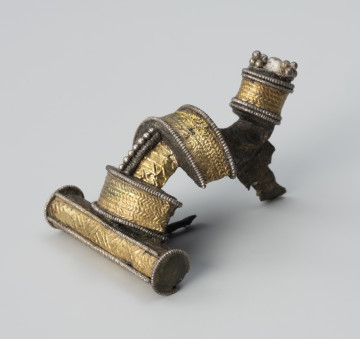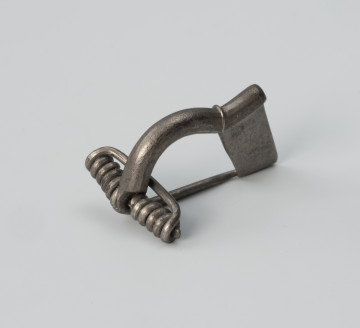
Fibula decorated with applications
150 — 200
National Museum in Szczecin
Part of the collection: Antiquity
The barrow burial ground in Gronów (German. Groß Grünow) near Drawsko Pomorskie is one of the most important sites of the Wielbark culture in Pomerania. It was discovered in 1881. The first researcher of the necropolis was Pastor Plato from Zlocieniec, who carried out amateur surveys in 1881, 1887 and 1890. Another discovery took place in 1926 during the construction of the road to Zlocieniec. It was a skeletal tomb furnished with Roman imports. Between 1939 and 1940, several pit graves were encountered during the construction of the Berlin-Szczecin-Gdańsk motorway. They were excavated by the Drawsko-based social conservationists Heinz Hinz and Dr Faust. Subsequently, the area of the burial ground was reforested as the construction of the aforementioned motorway was abandoned between 1940 and 1941. The methodical excavations from which the presented bracelet comes took place between 1973 and 1977 under the direction of Ryszard Wolłągiewicz (1933-1994) of the National Museum in Szczecin. A total of 56 cremated and inhumation burials were discovered in the burial ground, 49 of which were covered by barrow mounds. A silver serpentine bracelet with a capsule clasp, the main decorative element of the bracelet, dating to the second half of the 2nd century was also discovered. Its front plate, however, has not survived. It was probably decorated with filigree and pearl wire – analogous to a second, twin bracelet from the same tomb (cf: MNS/A/19666/1). Both were part of a rich skeletal burial of a woman of high social status. This is evidenced, among other things, by the possessions that were found, such as bronze and silver jewellery, some gilded, and spinning accessories. All the artefacts were found in grave number 4, which, along with four others, was covered by barrow 22. Bartłomiej Rogalski
Author / creator
Object type
wave bracelet
Technique
casting, forging, cutting, soldering
Material
silver
Origin / acquisition method
field research
Creation time / dating
Creation / finding place
Owner
Muzeum Narodowe w Szczecinie
Identification number
Location / status

150 — 200
National Museum in Szczecin

150 — 200
National Museum in Szczecin

80 — 160
National Museum in Szczecin
DISCOVER this TOPIC
Museum of King Jan III's Palace at Wilanów
DISCOVER this PATH
Educational path